| CPC G06Q 20/108 (2013.01) [G06N 20/00 (2019.01); G06Q 20/3221 (2013.01); G06Q 20/3223 (2013.01); G06Q 20/4037 (2013.01); G06Q 20/405 (2013.01); G06Q 30/0283 (2013.01); G06Q 40/02 (2013.01); G06Q 20/023 (2013.01); G06Q 30/0185 (2013.01); G06Q 50/01 (2013.01)] | 22 Claims |

|
1. A system for integrating web platforms with mobile device operations, comprising: a memory storing instructions; and at least one processor configured to execute the instructions to perform operations comprising:
associating a user with an account at an institution;
analyzing an account balance of the account;
storing, at a first database, financial history data associated with the user;
accessing non-financial data and scheduled transaction data from a second database, wherein scheduled transaction data includes data associated with direct deposits and automatic billing;
providing for display, on a display of a mobile device, a setup dashboard configuration comprising a plurality of setup graphical user interfaces, including:
a first setup interface for receiving a first setting for a balance threshold, wherein the first setup interface provides a first interactive sliding control that allows the user to select a low balance mode threshold;
a second setup interface for receiving a second setting for at least one default payment behavior when the account is in a low balance mode, wherein the second setting is received using a first interactive toggle control, and wherein the second setting instructs the processor whether to approve or deny check payments and automatic payments initiated before entering the low balance mode;
replacing the setup dashboard configuration with an account management dashboard configuration comprising one or more account management interfaces having selectable controls associated with processing a plurality of transactions while outside of the low balance mode;
analyzing, using a machine learning algorithm, the financial history data and the non-financial data;
determining, using the machine learning algorithm, a future account balance of the account based on the account balance, the scheduled transaction data, the financial history data, and the non-financial data;
determining whether the account is in the low balance mode based on the future account balance; and
responsive to determining that the account is in the low balance mode, disabling and replacing the account management dashboard configuration with a low balance mode dashboard configuration comprising one or more low balance mode user interfaces different from setup user interfaces and different from the account management user interfaces, wherein the low balance mode user interfaces comprise:
an indication that the account is in the low balance mode;
a set of electronic transaction controls restricted to account funding controls; and
one or more default payment controls for processing previously scheduled automatic payments while the account is in the low balance mode,
wherein the processor permits the user to perform a limited set of electronic banking operations associated with the set of electronic transaction controls and the one or more default payment controls, including:
providing a payment grace period selection from a plurality of grace period options, wherein the plurality of payment grace period options are determined, using the machine learning algorithm, by analyzing the financial history data and the non-financial data, and the scheduled transaction data, including: a typical balance of the user's account, the user's standing with the institution, the user's actions while in the low balance mode, and historical occurrences of a negative balance in the user's account;
notifying the user of the payment grace period, the plurality of grace period options, and a period of time remaining before the user will incur additional costs;
notifying the user throughout the grace period at predetermined times if the account is still in the low balance mode, where the low balance mode dashboard displays information about the payment grace period, including a minimum required deposit and a time remaining until an overdraft fee will be charged if the account is in the low balance mode, and the low balance mode dashboard is disabled and replaced by the account management dashboard if the account is no longer in the low balance mode.
|
|
2. The system of claim 1, wherein the at least one processor is configured to execute the instructions to perform operations further comprising:
determining the predetermined times using the machine learning algorithm, by analyzing the financial history data and the non-financial data, and the scheduled transaction data.
|
|
3. The system of claim 1 wherein the at least one processor is configured to execute the instructions to perform operations further comprising:
providing the option for the user to select the predetermined times.
|
|
4. The system of claim 1, wherein analyzing the financial history data comprises:
identifying a pattern of transactions relating to the account;
and predicting a cashflow based on the pattern.
|
|
5. The system of claim 4, wherein identifying the pattern of transactions includes identifying at least one of a predicted transaction time period or a predicted transaction amount.
|